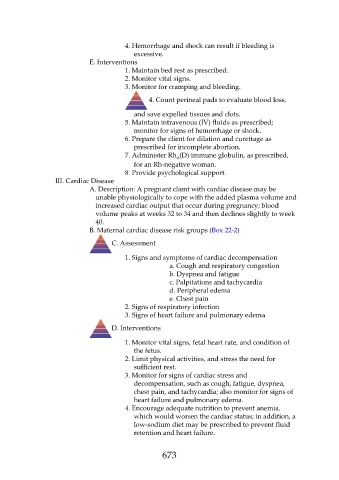Page 673 - Saunders Comprehensive Review For NCLEX-RN
P. 673
4. Hemorrhage and shock can result if bleeding is
excessive.
E. Interventions
1. Maintain bed rest as prescribed.
2. Monitor vital signs.
3. Monitor for cramping and bleeding.
4. Count perineal pads to evaluate blood loss,
and save expelled tissues and clots.
5. Maintain intravenous (IV) fluids as prescribed;
monitor for signs of hemorrhage or shock.
6. Prepare the client for dilation and curettage as
prescribed for incomplete abortion.
7. Administer Rh (D) immune globulin, as prescribed,
o
for an Rh-negative woman.
8. Provide psychological support.
III. Cardiac Disease
A. Description: A pregnant client with cardiac disease may be
unable physiologically to cope with the added plasma volume and
increased cardiac output that occur during pregnancy; blood
volume peaks at weeks 32 to 34 and then declines slightly to week
40.
B. Maternal cardiac disease risk groups (Box 22-2)
C. Assessment
1. Signs and symptoms of cardiac decompensation
a. Cough and respiratory congestion
b. Dyspnea and fatigue
c. Palpitations and tachycardia
d. Peripheral edema
e. Chest pain
2. Signs of respiratory infection
3. Signs of heart failure and pulmonary edema
D. Interventions
1. Monitor vital signs, fetal heart rate, and condition of
the fetus.
2. Limit physical activities, and stress the need for
sufficient rest.
3. Monitor for signs of cardiac stress and
decompensation, such as cough, fatigue, dyspnea,
chest pain, and tachycardia; also monitor for signs of
heart failure and pulmonary edema.
4. Encourage adequate nutrition to prevent anemia,
which would worsen the cardiac status; in addition, a
low-sodium diet may be prescribed to prevent fluid
retention and heart failure.
673

